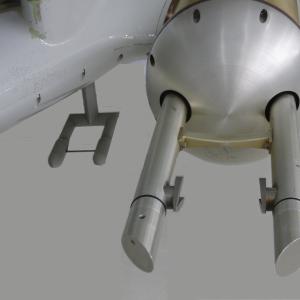The 2DC probe records images of hydrometeors that pass through its sample volume, and so provides measurements of ice or water drop concentration, their size distribution, and their shapes. It obtains these images by recording the status (illuminated or shadowed) of a 64-element photodiode array as the shadow of the hydrometeor passes over the array. Probes with 25 µm and 10 µm resolution are available; at 25 µm, the 64-element array provides a sample of about 8 L per 100 m of flight. Images of individual particles are recorded, usually with no loss except at very high concentrations. Special records containing these images in digital form are recorded as needed, so they will be interspersed with the standard periodically sampled records. The 2DC probe was originally manufactured by Particle Measuring Systems, Inc., but the electronics have been replaced with high-speed circuitry matched to the flight speed of the G-V, data transmission has been changed to USB-2, the photodiode array was replaced with one having twice as many elements and supporting faster response, and other changes were made to the optics and electronics of the G-V 2DCs.
Because the depth of field reduces to less than the distance between the arms that define the sample aperture for particle sizes less than about 125 µm, and because diffraction makes the sizes of such small particles hard to determine, the probe has limited ability to measure concentrations at sizes less than about 100 µm, even though it has resolution smaller than this. The array size and optics limit the largest size that can be imaged fully to 1600 µm for the 25-µm-resolution probe. The probe also has been shown to measure falsely high concentrations as a result of shattering (Korolev et al., 2011), so new tips have been installed that reduce but do not eliminate the effects of shattering.


